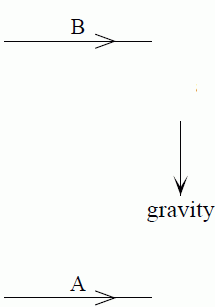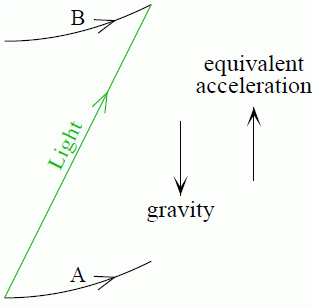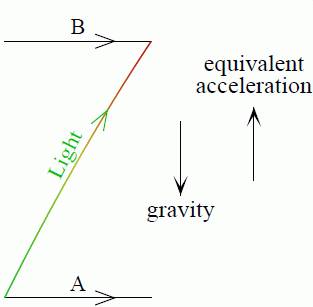 Spring 2012 ASTR 2030 Homepage
Spring 2012 ASTR 2030 Homepage
The Principle of Equivalence of gravity and acceleration
How do you apply the Principle of Equivalence?
Suppose you are in a gravitating system.
The Principle of Equivalence
asserts that a gravitating frame is equivalent to an accelerating frame.
Go into a free-fall, non-accelerating frame.
Ask, what happens in the free-fall frame?
In the free-fall frame,
unaccelerated objects move in straight lines at constant velocity.
Whatever happens there tells you what happens
back in the gravitating/accelerating frame.
|
A cannonball, seen through a window.
|
|
|
|
The same cannonball,
but now you and the window are falling freely.
In the free-fall frame,
the cannonball follows a straight line trajectory.
|
|

|
|

|
Two consequences of the Principle of Equivalence:
gravitational redshift, and the gravitational bending of light
|
A and B, who are moving to the right slowly,
are in a gravitational field that points downward.
|
|
|
|
Equivalently, A and B
are accelerating upward.
This shows the situation as seen in a freely-falling frame.
|
|

|
|

|
|
A sends a light ray to B.
In the freely-falling frame,
the light follows a straight line,
and its frequency is constant.
During the time that the light goes from A to B,
B has accelerated upwards a bit.
Since B is moving upwards,
away from A's original position,
B sees the light redshifted compared to A.
|
|
|
|
What B sees is what B sees, regardless of frame.
So B sees the light redshifted in the gravitating frame.
In the gravitating/accelerating frame,
the light follows a curved line,
and it appears to redshift.
|
|

|
|

|
Third consequence of the Principle of Equivalence:
spacetime is curved
|
Two light rays approach the Earth on parallel lines.
Each light ray follows a straight line relative to free-fall frames along its path.
But the light rays converge in the gravitating frame.
Einstein's conclusion:
gravity curves spacetime.
|
|

|
How mass-energy curves spacetime: Einstein's (1915) equations
The Principle of Equivalence determines only how objects move in the curved
spacetime produced by a gravitational field,
not how mass curves spacetime.
It took Einstein several years, until 1915,
eventually to come up with his “Einstein equations”,
which describe mathematically how mass-energy-momentum curves spacetime.
Einstein's equations have an iconic status, second only to his
E = mc2
equation.
They look like this:
These equations actually represent not one but ten distinct equations.
You do not have to understand the mathematical meaning of the equations,
which is notoriously difficult.
However, their physical meaning is this:
Geometry
(curvature)
of spacetime
|
=
|
energy-momentum
content
of spacetime
|
|
In general relativity,
spacetime can in principal be arbitrarily curved.
General relativity opens the possibility
of pulling spacetime around, like playdoh, into fantastical shapes.
For example,
one place could be linked by a wormhole shortcut to another far distant place,
allowing super-fast intergalactic travel.
Or, the future could be linked to the past,
allowing time travel.
Unfortunately,
Einstein's equations cut short such dreams.
You are free to specify whatever curved spacetime you like,
but then Einstein's equations tell you how you must arrange mass-energy
in order to produce your desired spacetime.
There are two problems with this.
First,
curving spacetime substantially
requires a lot of mass in a small space
—
like a black hole.
Second,
making something like a wormhole
generically requires gravitationaly repulsive negative mass
(which Thorne calls “exotic matter”).
 Spring 2012 ASTR 2030 Homepage
Spring 2012 ASTR 2030 Homepage
Updated 2012 Jan 16








